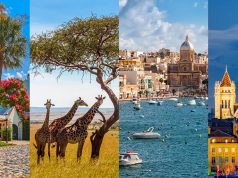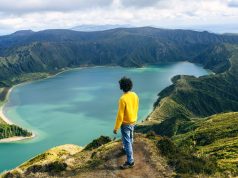By Zainab AbdulAziz
Imagine embarking on a 550km hike across Sinai. How long would that take? A month? 42 days, in fact. Now imagine you’re crossing through eight different territories and meeting eight different local tribes and Bedouin guides. That is the ambitious undertaking Sinai Trail founders worked towards and ultimately realized, according to co-founder Ben Hoffler.
The group spent one year scouting the best line for a hiking trail, settling on a 220km route between Nuweiba and St Katherine which passed through the territories of three Bedouin tribes, and required cooperation with tribe leaders to guide hikers through its lands. As the project grew, the trail doubled to a 550km circuit traversing all eight territories in South Sinai. An intertribal cooperative was formed and an agreement made in Bedouin law bringing together the tribes to manage the project collectively. The Sinai Trail is now 100% owned by the Bedouin of the Sinai and managed by them today.
Tell us the story of how the idea for Sinai Trail and Red Sea Mountain Trail came about?
The Sinai Trail was born in the hardest time for tourism in Egypt. We wanted to create a single trail to bring the community together, seeing unity as the best way through the hard times. We spent one year scouting the best line for the new trail, creating a 220km route between Nuweiba and St Katherine.
Initially the trail crossed the territories of three Bedouin tribes, and leaders of these tribes agreed to cooperate guiding hikers; each tribe would guide hikers through its lands to the borders of the next tribe. As the project grew and gained momentum, the trail extended to a 550km circuit traversing the territories of all eight tribes in South Sinai. After this, an intertribal cooperative was formed and an agreement made in Bedouin law, bringing together these eight tribes to manage the project collectively.
The Sinai Trail is 100% owned by the Bedouin of the Sinai and they manage it today. They have seen the strength that comes through being together and how by pooling skills, knowledge and expertise, they can go further. One day, we hope the Sinai Trail will be extended to include new tribes.
The Red Sea Mountain Trail is a new, 170km hiking trail outside Hurghada which traverses the highest summits in mainland Egypt and around it lay 600km of secondary hiking trails which, collectively, surpass the Sinai Trail in length. The Red Sea Mountain Trail opens up a genuinely new frontier for tourism in the Middle East, mostly unseen outside the Bedouin community.


Today, the two trails work as sister trails, cooperating to boost Egypt’s adventure tourism and to create new jobs for marginalized Bedouin communities, taking them out of service roles and repositioning them as leaders. The trails also preserve traditional knowledge, skills and heritage which are critically endangered as more Bedouin abandon the desert for the towns. Visitors on both trails can access a unique, age-old experience walking with the Bedouin. Tourism is shifting away from old school models of sightseeing and is becoming more about authentic, cultural immersion, where people experience and learn from others different to themselves. That’s exactly what these trails do so well, which is why they’re becoming more popular.
How do you assure the safety of the hikers who travel with you, for people who are nervous about being out of their comfort zones?
Safety is the most important thing. We ask lots of questions to ensure every hiker is suited for whatever trip they join. For long hikes, we run special training and assessment sessions in Wadi Degla, in Cairo.
On the Sinai Trail, I would argue our Bedouin guides are amongst the most highly trained in Egypt. Along with decades of experience, every guide has attended Wilderness First Aid training. On long hikes, we keep track of groups and know whereabouts they are all the time. We carry emergency shelters. Whatever we do in life, whether we’re flying, or driving, or walking, we can never take the risk completely out and it’s important every hiker understands and accepts that any hike brings risks with it.
Nevertheless, it’s important to keep everything in perspective. Many men and women, old and young, from all over the world, have hiked the Sinai Trail; many understood the day-to-day reality of hiking, and how in many ways it’s safer and better for their health than walking in crowded, polluted cities full of cars and other moving dangers. Sometimes people even find it hard to leave the trail and return to their former urban comfort zone.
Photography Credit: Ben Hoffler
What’s the best weather to hike in these areas?
Autumn and spring are the most popular hiking seasons. They’re transitional times with not too hot, not too cold weather conditions, and they are also the seasons when things begin to change. Autumn brings clouds and a beautiful, broken light over the desert. In the Red Sea Mountains, it’s the time when rain is most likely. Orchard trees turn crimsons and yellows in the highlands of St Katherine. Flocks of white storks fly overhead like gigantic arrows, heading to Africa to escape the European winter.
Spring is the most fabled, beloved time for the Bedouin. Everywhere begins to feel alive; the desert revives itself. Colorful wildflowers and grasses bloom. If rains were good the previous winter, waterfalls flow in the wadis. White storks fly back over again, returning to Europe for summer.
Winter brings the coldest weather – sometimes sub-zero in the highlands – which is too cold for some hikers. For me, it’s always a special time. Everywhere feels wild, windswept, empty and hard. Sometimes, there’s snow. For a day or two, the mountains of Egypt can look like the Alps. Fires bring people together in the cold winter nights. The Bedouin say summers are becoming hotter in modern times. Early starts and long sit-outs in hot afternoons are the only way to hike safely. One option in the summer, which I like, is to hike at night. If you time a hike with the full moon, a silvery glow hangs over the landscape, especially in wide, open spaces; moving through the darkness feels ethereal, like walking in a dream.
How long does the typical hike take?
On the Sinai Trail, a typical long hike, with a group, is 12 days. We’re organizing the longest hike this coming autumn; a 36 day hike on the new, extended Sinai Trail, from the Gulf of Aqaba to the Gulf of Suez, through the territories of eight Bedouin tribes. It’ll be broken into three separate parts, each one 12 days, so people can join it for 12 days, or 24 days, or even the full 36 days. It’s probably one of the longest hikes ever organized in Egypt. In 2020, we want to organize an even longer hike, over the entire 550km Sinai Trail, taking 42 days.
How would you guys recommend people prepare for this sort of adventure, in terms of hiking gear and necessities?
Generally, hike as light as possible. Most of the stuff you think you’ll need, you probably won’t. Most of us are used to having our possessions close around us, or at least being close to places we can buy what we need, so when we leave home there is often an impulse to take as much of it as possible.
The easiest thing is to overpack. Going light is harder. Travelling light takes time to master, but once you do most people find it liberating. Travelling light creates a closer relationship between you and your surroundings; you become more critical and observant of what’s around you, learning to notice what is there already – whether natural shelter or a piece of discarded rope for getting water – rather than using whatever is inside your bag.
Don’t ever think if you don’t have the big brand, high-cost outdoors gear many hikers wear, you won’t be able to hike on the Sinai Trail. The Bedouin are living proof the inverse is true. Whilst I wouldn’t recommend everybody travels as light as the Bedouin, and certainly not at first, remember you can almost certainly go lighter and lower cost than you might think.
Suitable clothes, footwear and sleeping gear are the basics, plus a bag to carry everything in. After that, a few other essentials. What most hikers truly miss over a long walk in the wilderness is just their favorite snack.
How can hikers prevent blisters?
Quickest, simplest advice is to toughen up your feet and avoid bad-fitting, hot, muggy footwear. The more you walk, the tougher your feet get; thick, hard, dry skin develops around the heels, balls, edges and toes. Blisters form through friction, as footwear rubs against your skin, and tough skin is more resistant to this than anything soft, smooth and pedicured. Specialist hiking sandals are a good anti-blister strategy. Sandals keep your feet open, aired and dry. There’s less rubbing from a sandal than a shoe, which covers the whole of your foot. If
All Photos Credit of Ben Hoffler
The Sinai Trail





